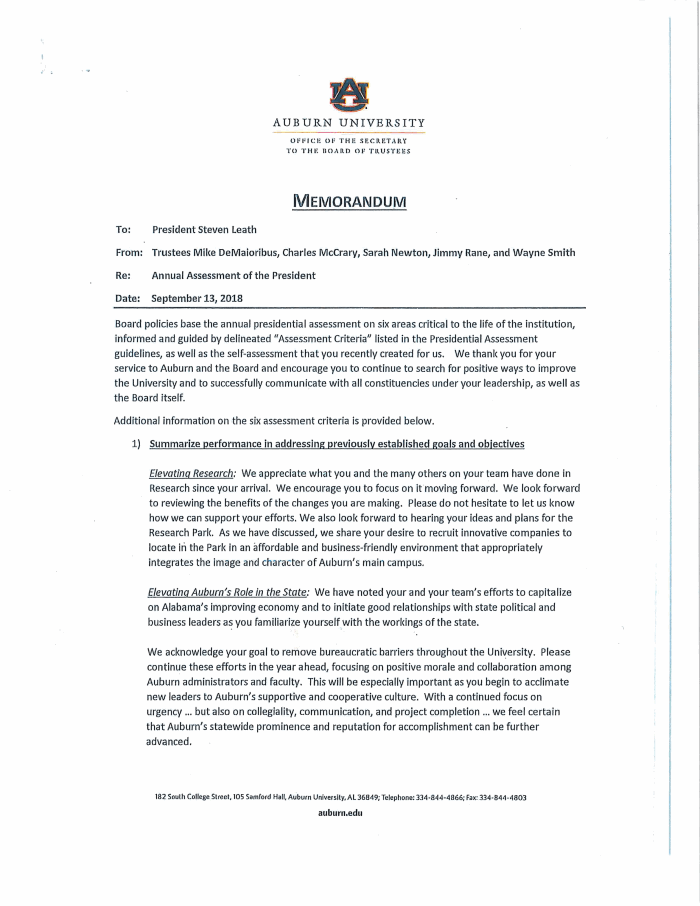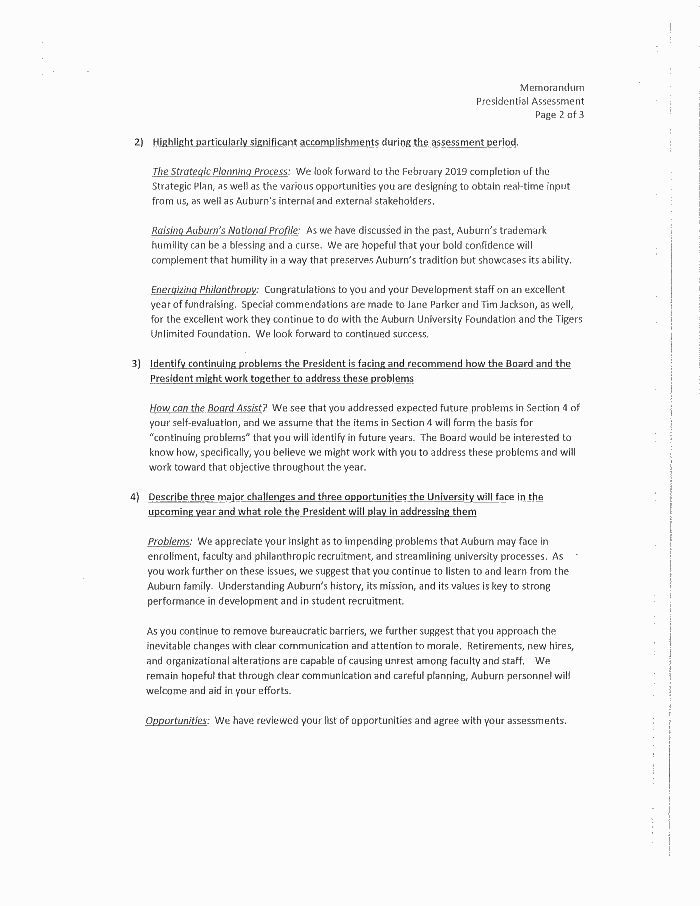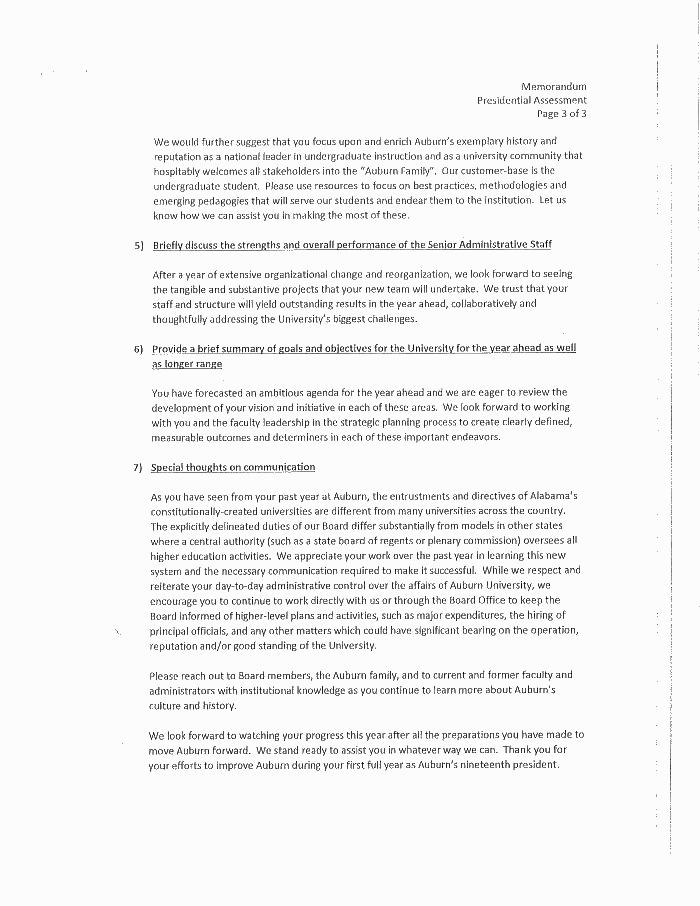Apparently "Crash" wasn't a good-enough good-ol-boy for Auburn.
Before His Ouster, Trustees Cautioned Auburn U.’s High-Flying President
By Jack Stripling JULY 30, 2019

The Auburn Plainsman
Auburn trustees warned Steven Leath, seen here in 2017, that the sweeping changes he had made as president could cause “unrest.”
Not long after Steven Leath was hired as president of Auburn University, in 2017, some on the campus took to calling him “Crash.”
The nickname was a nod to Leath’s notorious hard landing of a university-owned airplane at Iowa State University, where he had previously been president, as well as a commentary on a swaggering style that rubbed some people in Auburn the wrong way.
The airplane incident at Iowa State raised questions about whether he had casually mixed business and pleasure on the university’s dime. But it also helped to flesh out the portrait of a loveable rogue — an aviating, bow-hunting, dog-loving, gray-bearded outdoorsman who relished squashing the competition. Leath was the sort of guy who, at least on paper, seemed a natural fit for a football-crazed public university in the Deep South, looking to raise its national profile.
Alas, it was not to be. After just two years, Leath is out of a job, and Auburn is out $4.5 million — using revenues from tuition and fees to pay off a president for a less-than-historic tenure. The separation agreement, which was reached in June, is designed to ensure that the public never knows exactly why this brief marriage ended so poorly.
But documents and interviews suggest that Auburn’s trustees and some faculty members had misgivings early on about Leath’s approach to the job, and his brimming self-confidence was seen as a mixed bag.
Some of these concerns are alluded to in the trustees’ first and only full evaluation of Leath, concluded in 2018, which has heretofore escaped public scrutiny. A report of the three-page evaluation, which the university provided to The Chronicle in response to a public-records request, urges Leath to “focus on urgency … but also on collegiality,” underscores the importance of balancing his “bold confidence” with Auburn’s “trademark humility,” and cautions Leath that the swift changes he made within the administration had the potential to create “unrest.”



The evaluation, submitted by a five-member assessment committee of the board, provides a peek into the value that trustees place on a president’s cultural fit and the subtle ways that boards encourage course corrections. The evaluation is a diplomatic document that spares Leath any overt criticism. It is peppered, however, with what in hindsight read as oblique references to a president who did not yet understand the university’s culture or instinctively appreciate the importance of “focusing on positive morale and collaboration.”
Leath’s first year was one of sweeping personnel changes, as several key administrators retired or took other jobs. This carried risks, the board said.
“As you continue to remove bureaucratic barriers, we further suggest that you approach the inevitable changes with clear communication and attention to morale,” the report states. “Retirements, new hires, and organizational alterations are capable of causing unrest among faculty and staff. We remain hopeful that through clear communication and careful planning, Auburn personnel will welcome and aid in your efforts.”
What has not spawned unrest is Leath’s ouster. No emergency meetings of the University Senate, no public demand for answers. That may have a lot to do with the academic calendar, as many students and professors have left campus for the summer. But no one seems particularly upset that Leath is gone.
“You can infer a lot by the faculty response to this,” said John Carvalho, a professor and associate director for journalism.
On Monday the Senate’s executive committee sent a note to faculty members. “It is unlikely that further information will be made public” about Leath’s resignation, the note said, because of confidentiality provisions in the separation agreement.
Efforts to reach Leath were unsuccessful. Auburn’s trustees have declined or not responded to interview requests.
Promises, Promises
Leath came to Auburn as an outsider, and questions emerged early on about whether he understood the university’s ethos. A plant scientist with degrees from Pennsylvania State University, the University of Delaware, and the University of Illinois at Urbana-Champaign, he was the first Auburn president in a long time with no clear connection to “the Plains,” as the campus is known.
Since the 1980s, all but one of Auburn’s presidents have either held degrees from the university or ascended from its ranks. The lone exception was William V. Muse, and that didn’t work out well, either. Muse butted heads with the university’s governing board, which fired him in 2001, escalating concerns about trustee micromanagement, particularly in athletics. Citing those concerns, Auburn’s accrediting agency put the university on probation nearly three years later.
But under Jay Gogue, who preceded Leath, Auburn’s fierce governance battles died down. Even firebrand faculty members describe Gogue’s 10-year run with fondness. The board has now turned to Gogue — who holds two degrees from Auburn — yet again to stabilize the university, pulling him out of retirement this month to serve as interim president.
Gogue was known for opening the president’s residence to trustees and faculty members. He revived a tradition of having former University Senate leaders over for dinner, and he extended the invitation to leaders of Auburn’s chapter of the American Association of University Professors, an organization that had long been at odds with the administration. Leath did not have the same reputation for openness.
In the trustees’ evaluation of Leath, they encouraged him to focus on Auburn’s reputation as a place that “hospitably welcomes” people. He should tap into the university’s old guard, trustees advised, to learn more about “Auburn’s culture and history.”
Leath’s deviations from tradition weren’t always welcome. He created a chief-of-staff position, for example, which some professors saw as a way of walling off the president. He filled that slot with Miles Lackey, who had served in the same role under Leath at Iowa State.
Lackey stayed at Auburn for only three months before taking a job in North Carolina. Short as his tenure was, it proved long enough for the joke to stick that Leath had literally brought his own “lackey” with him to Auburn. (Lackey did not respond to interview requests).
One of Gogue’s first moves upon his return to Auburn was to eliminate the new position.
“The chief of staff position was created by Dr. Leath,” Brian Keeter, a university spokesman, said in an email to The Chronicle. “It’s a role Auburn didn’t have previously, and the need for the position no longer existed after his departure.”
John M. Mason Jr., who resigned as Auburn’s vice president for research and economic development to become chancellor of Penn State at Harrisburg, was another key administrator to depart during Leath’s first year. Mason, who described Leath as a person with ambitious goals for the university, said he left Auburn for the opportunity to return to his alma mater. He offered no direct criticism of Leath, a person with whom he said he had “reasonably pleasant conversations.”
“The things we were trying to do would be for the long-term benefit,” Mason said, “so I would have expected that he would have been successful for a longer period of time.”
Some people were skeptical, however, about Leath’s grand plans.
He was applauded for setting a goal to hire 500 tenure-track faculty members by 2022, but the fine print showed that Auburn’s professorial ranks would grow by only about 100 once attrition and retirements were factored in.
“He made promises that it was clear to me he couldn’t keep,” said Barry R. Burkhart, a professor emeritus of psychology and a former chairman of the University Senate, who retired in late 2018 after 44 years at Auburn. “We’re going to get 500 new faculty — well, that’s not going to happen. It was those intemperate, self-aggrandizing things that put me off. I was just waiting for him to go.”
Leath made promises to the board, too. In his written self-assessment, Leath said Auburn would expand its presence in Birmingham, Ala., ending the dominance of “another institution” that for too long had bested Auburn in competition for students, corporate partnerships, and reputational stature. This is surely a reference to the University of Alabama, Auburn’s chief football rival. Leath sounded more like a cocksure quarterback than an administrator as he laid out his plans.
“We aim to end their reign in Birmingham,” he wrote.
As much as Leath seemed to relish Auburn’s big-time sports culture, he managed to get crosswise with the Tiger fan base on several occasions. There were complaints that he appeared insufficiently supportive of Bruce Pearl, the men’s basketball coach, when the program became embroiled in a bribery scandal that involved numerous universities. Contrarily, some thought Leath was overly generous to Gus Malzahn, the football coach, who secured a seven-year, $49 million contract with the university.
[continued in next post due to limits on content size]
Before His Ouster, Trustees Cautioned Auburn U.’s High-Flying President
By Jack Stripling JULY 30, 2019

The Auburn Plainsman
Auburn trustees warned Steven Leath, seen here in 2017, that the sweeping changes he had made as president could cause “unrest.”
Not long after Steven Leath was hired as president of Auburn University, in 2017, some on the campus took to calling him “Crash.”
The nickname was a nod to Leath’s notorious hard landing of a university-owned airplane at Iowa State University, where he had previously been president, as well as a commentary on a swaggering style that rubbed some people in Auburn the wrong way.
The airplane incident at Iowa State raised questions about whether he had casually mixed business and pleasure on the university’s dime. But it also helped to flesh out the portrait of a loveable rogue — an aviating, bow-hunting, dog-loving, gray-bearded outdoorsman who relished squashing the competition. Leath was the sort of guy who, at least on paper, seemed a natural fit for a football-crazed public university in the Deep South, looking to raise its national profile.
Alas, it was not to be. After just two years, Leath is out of a job, and Auburn is out $4.5 million — using revenues from tuition and fees to pay off a president for a less-than-historic tenure. The separation agreement, which was reached in June, is designed to ensure that the public never knows exactly why this brief marriage ended so poorly.
But documents and interviews suggest that Auburn’s trustees and some faculty members had misgivings early on about Leath’s approach to the job, and his brimming self-confidence was seen as a mixed bag.
Some of these concerns are alluded to in the trustees’ first and only full evaluation of Leath, concluded in 2018, which has heretofore escaped public scrutiny. A report of the three-page evaluation, which the university provided to The Chronicle in response to a public-records request, urges Leath to “focus on urgency … but also on collegiality,” underscores the importance of balancing his “bold confidence” with Auburn’s “trademark humility,” and cautions Leath that the swift changes he made within the administration had the potential to create “unrest.”



The evaluation, submitted by a five-member assessment committee of the board, provides a peek into the value that trustees place on a president’s cultural fit and the subtle ways that boards encourage course corrections. The evaluation is a diplomatic document that spares Leath any overt criticism. It is peppered, however, with what in hindsight read as oblique references to a president who did not yet understand the university’s culture or instinctively appreciate the importance of “focusing on positive morale and collaboration.”
Leath’s first year was one of sweeping personnel changes, as several key administrators retired or took other jobs. This carried risks, the board said.
“As you continue to remove bureaucratic barriers, we further suggest that you approach the inevitable changes with clear communication and attention to morale,” the report states. “Retirements, new hires, and organizational alterations are capable of causing unrest among faculty and staff. We remain hopeful that through clear communication and careful planning, Auburn personnel will welcome and aid in your efforts.”
What has not spawned unrest is Leath’s ouster. No emergency meetings of the University Senate, no public demand for answers. That may have a lot to do with the academic calendar, as many students and professors have left campus for the summer. But no one seems particularly upset that Leath is gone.
“You can infer a lot by the faculty response to this,” said John Carvalho, a professor and associate director for journalism.
On Monday the Senate’s executive committee sent a note to faculty members. “It is unlikely that further information will be made public” about Leath’s resignation, the note said, because of confidentiality provisions in the separation agreement.
Efforts to reach Leath were unsuccessful. Auburn’s trustees have declined or not responded to interview requests.
Promises, Promises
Leath came to Auburn as an outsider, and questions emerged early on about whether he understood the university’s ethos. A plant scientist with degrees from Pennsylvania State University, the University of Delaware, and the University of Illinois at Urbana-Champaign, he was the first Auburn president in a long time with no clear connection to “the Plains,” as the campus is known.
Since the 1980s, all but one of Auburn’s presidents have either held degrees from the university or ascended from its ranks. The lone exception was William V. Muse, and that didn’t work out well, either. Muse butted heads with the university’s governing board, which fired him in 2001, escalating concerns about trustee micromanagement, particularly in athletics. Citing those concerns, Auburn’s accrediting agency put the university on probation nearly three years later.
But under Jay Gogue, who preceded Leath, Auburn’s fierce governance battles died down. Even firebrand faculty members describe Gogue’s 10-year run with fondness. The board has now turned to Gogue — who holds two degrees from Auburn — yet again to stabilize the university, pulling him out of retirement this month to serve as interim president.
Gogue was known for opening the president’s residence to trustees and faculty members. He revived a tradition of having former University Senate leaders over for dinner, and he extended the invitation to leaders of Auburn’s chapter of the American Association of University Professors, an organization that had long been at odds with the administration. Leath did not have the same reputation for openness.
In the trustees’ evaluation of Leath, they encouraged him to focus on Auburn’s reputation as a place that “hospitably welcomes” people. He should tap into the university’s old guard, trustees advised, to learn more about “Auburn’s culture and history.”
Leath’s deviations from tradition weren’t always welcome. He created a chief-of-staff position, for example, which some professors saw as a way of walling off the president. He filled that slot with Miles Lackey, who had served in the same role under Leath at Iowa State.
Lackey stayed at Auburn for only three months before taking a job in North Carolina. Short as his tenure was, it proved long enough for the joke to stick that Leath had literally brought his own “lackey” with him to Auburn. (Lackey did not respond to interview requests).
One of Gogue’s first moves upon his return to Auburn was to eliminate the new position.
“The chief of staff position was created by Dr. Leath,” Brian Keeter, a university spokesman, said in an email to The Chronicle. “It’s a role Auburn didn’t have previously, and the need for the position no longer existed after his departure.”
John M. Mason Jr., who resigned as Auburn’s vice president for research and economic development to become chancellor of Penn State at Harrisburg, was another key administrator to depart during Leath’s first year. Mason, who described Leath as a person with ambitious goals for the university, said he left Auburn for the opportunity to return to his alma mater. He offered no direct criticism of Leath, a person with whom he said he had “reasonably pleasant conversations.”
“The things we were trying to do would be for the long-term benefit,” Mason said, “so I would have expected that he would have been successful for a longer period of time.”
Some people were skeptical, however, about Leath’s grand plans.
He was applauded for setting a goal to hire 500 tenure-track faculty members by 2022, but the fine print showed that Auburn’s professorial ranks would grow by only about 100 once attrition and retirements were factored in.
“He made promises that it was clear to me he couldn’t keep,” said Barry R. Burkhart, a professor emeritus of psychology and a former chairman of the University Senate, who retired in late 2018 after 44 years at Auburn. “We’re going to get 500 new faculty — well, that’s not going to happen. It was those intemperate, self-aggrandizing things that put me off. I was just waiting for him to go.”
Leath made promises to the board, too. In his written self-assessment, Leath said Auburn would expand its presence in Birmingham, Ala., ending the dominance of “another institution” that for too long had bested Auburn in competition for students, corporate partnerships, and reputational stature. This is surely a reference to the University of Alabama, Auburn’s chief football rival. Leath sounded more like a cocksure quarterback than an administrator as he laid out his plans.
“We aim to end their reign in Birmingham,” he wrote.
As much as Leath seemed to relish Auburn’s big-time sports culture, he managed to get crosswise with the Tiger fan base on several occasions. There were complaints that he appeared insufficiently supportive of Bruce Pearl, the men’s basketball coach, when the program became embroiled in a bribery scandal that involved numerous universities. Contrarily, some thought Leath was overly generous to Gus Malzahn, the football coach, who secured a seven-year, $49 million contract with the university.
[continued in next post due to limits on content size]


